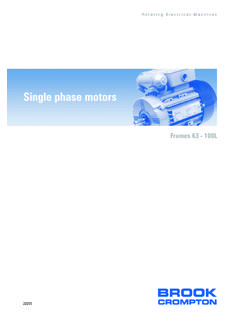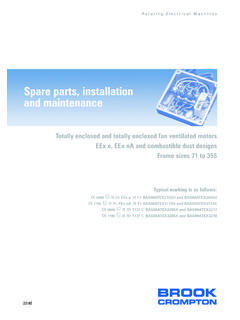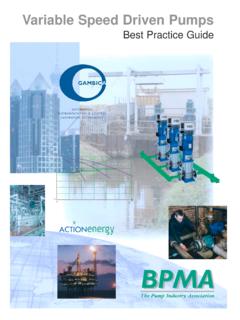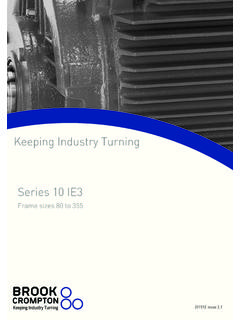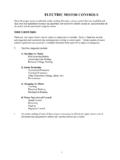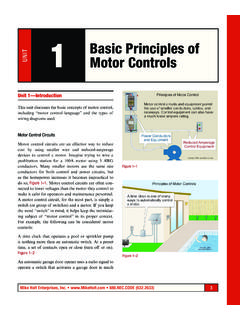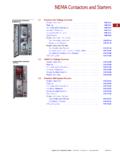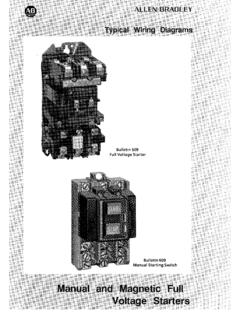Transcription of A Guide to Selection of Efficient Motors & Controls
1 A Guide to Selection of Efficient Motors & Controls The purpose of this Guide is to assist the end user in the Selection of the best motor and control technology for a given application. It addresses the differences in motor efficiency ratings, the considerations and benefits of different control methods, and the issues that affect the decision making process for fixed or variable speed control . Running Cost vs Purchase Cost The cost of buying an electric motor can be deceptive; in a single year the cost of energy can be up to 10 times the purchase cost. Over the life of the motor it is by far the most significant cost. 11 kW IE3 motor , 4000 operating hours per year, 15 year life cycle Source: EuP Lot 11, 2008 There are a number of ways of reducing these energy costs that more than pay for themselves. The purpose of this Guide is to help make the right decisions on selecting the most Efficient motor & control combination for the application.
2 Energy motor Efficiency As Motors have evolved, manufacturers have achieved greater efficiencies by the use of improved design, production techniques and materials. This now presents the user with a range of motor designs that offer different levels of efficiency. The International Electrotechnical Commission (IEC) has published an international standard that defines 3 distinct energy efficiency classes for single-speed, three-phase Motors (IE1, IE2, IE3). This standard has also been adopted as a European and UK Standard (BS EN 60034-30:2009). IE4 efficiency class is also in development. The IE classes replace the previous CEMEP EFF classes. IE1 Standard Efficiency EFF2 IE2 High Efficiency EFF1 IE3 Premium Efficiency - IE4 Super Premium Efficiency - (future development) Higher efficiency Motors cost more to purchase because of the more intensive production techniques and additional material costs.
3 However, the saving in operating energy costs can often offset the higher capital cost as shown in the graphs below. At 8000 operating hours per year, the additional cost of an IE2 motor is paid back in 7 months, with an IE3 motor paying back in 10 months. Even at only 2000 operating hours per year, the energy saving repays the capital in about 3 years. The European Ecodesign Directive* sets out mandatory minimum energy efficiency requirements for Motors that can be placed on the market. Date motor Range Minimum Efficiency Standard June 2011 kW to 375 kW IE2 (with fixed or variable speed control ) January 2015 kW to 375 kW IE3 (with fixed or variable speed control ) or IE2 with Variable Speed Drive January 2017 kW to 375 kW IE3 (with fixed or variable speed control ) or IE2 with Variable Speed Drive * The Ecodesign Directive (2009/125/EC) includes EuP (Energy Using Products) and ErP (Energy Related Products) 110 112 114 116 118IE1IE2IE315 Year Costs ( ,000)8000 operating hours CostPurchase CostEnergy 27 28 29 30IE1IE2IE315 Year Costs ( ,000)2000 operating hours for an 11kW 4 pole motor .
4 Source: EuP Lot 11, 2008 Energy costs adjusted to per kWh 15 T CO2 25 T CO2 585 3 T CO2 977 5 T CO2 1500 rpm1200 rpm with VSD1 kWVSD lossesMotor lossesVariable Speed Drives Many applications can benefit from the use of Variable Speed Drives (VSD) to better match the speed of the motor to the driven machinery. This can result in significant energy savings in addition to improved process control , reduced maintenance, longer system life, very soft start, improved flexibility, integration into automation systems, reduction in audible noise and increased performance. Typical applications that benefit from a VSD include most fans and pumps, turbo compressors and material handling amongst others. The relatively small losses in the Variable Speed Drive are easily compensated for by the overall improvement of the application efficiency To recoup the capital cost of a typical 11kW VSD only a modest energy saving is required.
5 Even with a 10% efficiency gain, the capital would be saved in only 1000 operating hours. Efficiency gains of between 20% and 70% are often possible in many fan and pump applications. Graph for an 11kW 4 pole motor with a pump/fan load type. Source: GAMBICA VSD Group, 2010 Fixed Speed control It is not always appropriate to consider variable speed control and there are many applications that can be run with a fixed speed control method ( motor Contactors or Soft Starters for example). A fixed speed control should be considered where; The load demands maximum motor speed Mechanical constraints do not permit speed variation Financial considerations ( Energy costs) do not justify payback of a VSD In these cases, the simplest and most effective method to reduce energy consumption is to switch off the motor when it is not required. By combining low voltage switchgear into well designed systems, significant energy savings can be achieved, and these savings are directly related to the amount of time the motor is switched off.
6 Typical techniques and applications are :- Level, Flow, Humidity, Temperature and Proximity Sensors can all be used to detect when a system or motor is required to operate PLC s (Programmable Logic Controllers) can be used to build intelligence within a system. They can be programmed to predetermined schedules, or react to sensors inputs, and to ensure the Motors only operate when required Soft Starters allow Motors to be stopped and restarted many times per hour, whilst reducing the mechanical stresses and wear normally associated with direct on line starting. Current inrush can also be reduced by typically 50% System Efficiency Selection of Motors and drives should be considered as only a part of the overall gains to be made. It is important to consider efficiency of the overall system, from the input of electrical energy to the useful output (air pressure, water flow rate etc). Maximising the reduction in operating costs can only be achieved through careful system design to achieve maximum efficiency gains, motor sizes can be reduced if drive train is more Efficient o Optimisation of the driven equipment o Optimisation of power transmission train (gearbox, belts and pulleys) VSD can eliminate the need for a gearbox, increasing system efficiency VSD operate at almost unity power factor - reducing reactive power charges and increasing overall efficiency Specifying As the energy cost is by far the most significant part of the lifecycle cost, it is recommended when specifying or purchasing a motor driven system to request not only a quote for the purchase cost, but also the annual operating cost.
7 A lower purchase cost may mean higher energy bills and greater life-cycle costs. To support this process is it important to have a clear expectation of the operating regime of the motor . Drivers As well as the financial benefit of using more Efficient drives and Motors , it will assist in compliance with or is required by Enhanced Capital Allowances (ECA) A tax allowance available when purchasing approved Motors and drives: Carbon Reduction Commitment (CRC) A mandatory cap and trade scheme for energy users ISO 16001 Energy Management An international management standard requiring monitoring and continuous improvement of energy management Energy Performance of Buildings (EPBD) Energy performance certification requirement Part L Building Regulations See documents L2A and L2B at Further GAMBICA / REMA publications are available online at GAMBICA Broadwall House, 21 Broadwall London, SE1 9PL Tel: +44 (0)20 7642 8080 REMA (A BEAMA Association) Westminster Tower, 3 Albert Embankment London, SE1 7SL Tel: +44 (0)20 7793 3006


